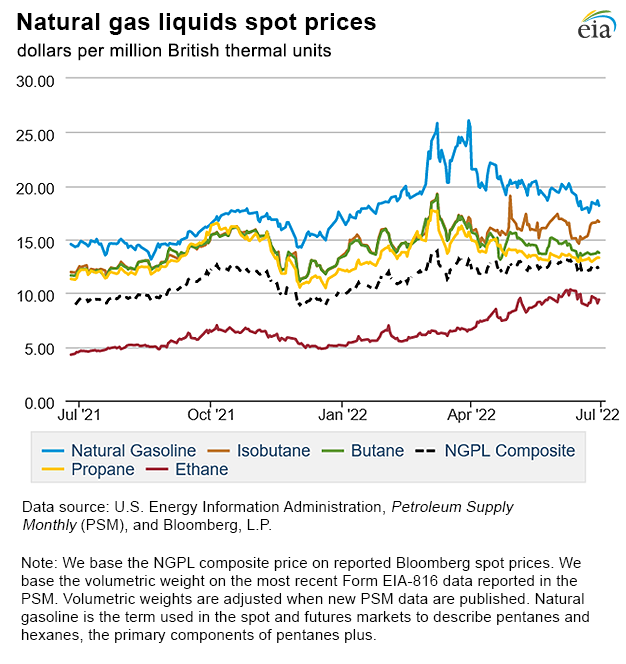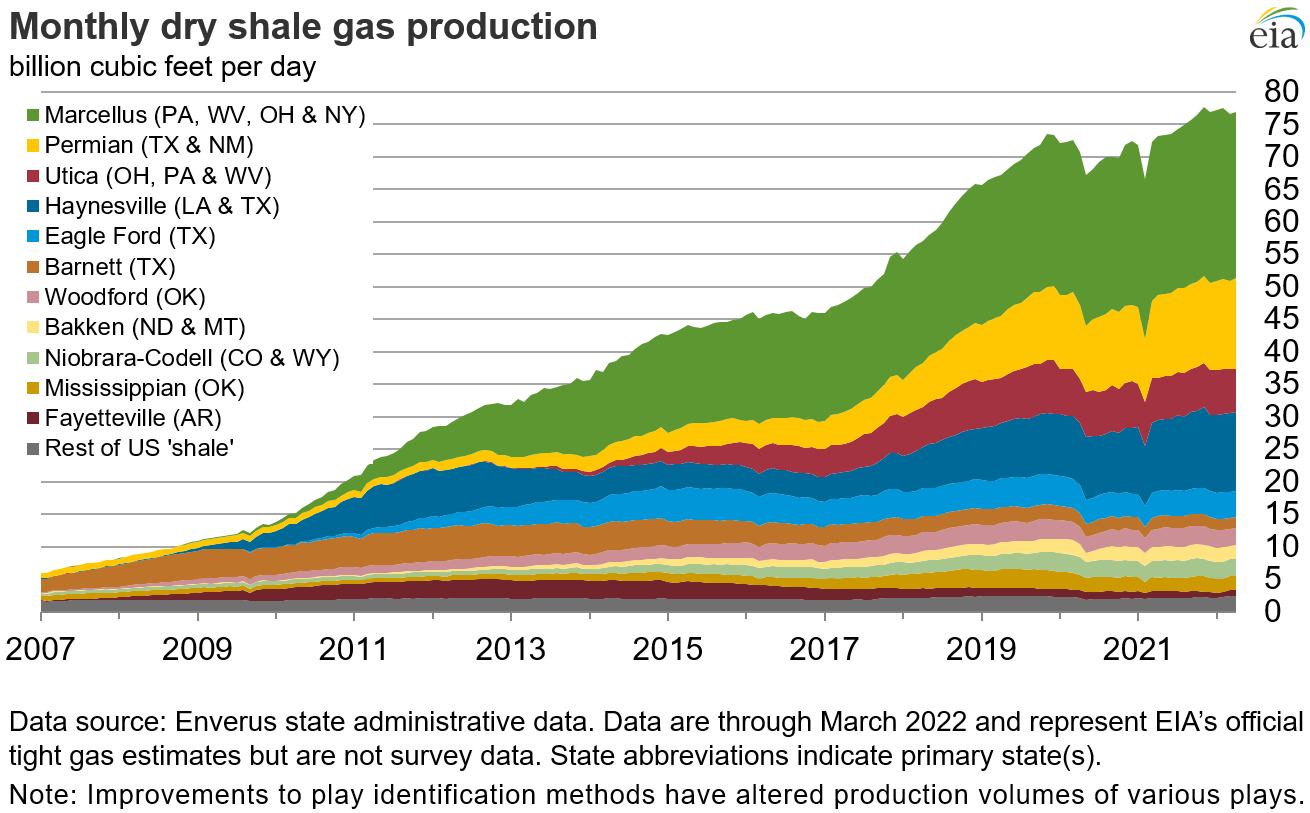In the News:
Global LNG trade grew by 4.5% in 2021
Global trade in liquefied natural gas (LNG) in 2021 increased by 2.2 billion cubic feet per day (Bcf/d), or 4.5%, compared with 2020 and averaged 49.0 Bcf/d, according to The LNG Industry GIIGNL Annual Report 2022 by the International Group of Liquefied Natural Gas Importers (GIIGNL). New LNG export capacity additions, primarily in the United States, as well as rising demand for natural gas in key LNG-consuming countries, contributed to continued growth in global LNG trade last year.
In the past five years (2017–2021), global LNG export capacity has increased by 14.0 Bcf/d (29%), led primarily by capacity additions in the United States (9.6 Bcf/d), Australia (2.2 Bcf/d), and Russia (1.7 Bcf/d). Last year, LNG exports increased the most from the United States, growing 2.9 Bcf/d (50%) compared with 2020. Australia increased its LNG exports by 0.1 Bcf/d (1%) and remained the world’s largest LNG exporter for the second consecutive year. In North Africa, LNG exports from Egypt and Algeria increased by 0.7 Bcf/d and 0.2 Bcf/d, respectively, representing the second- and third-largest year-on-year volumetric increases among all LNG-exporting countries. Egypt resumed LNG exports from Damietta LNG in early 2021. This liquefaction plant was shut down in 2012 because of shortages of natural gas feedstock.
Among LNG-importing regions, only Asia and Latin America posted an increase in annual imports. From 2020 to 2021, LNG imports increased in Asia by 2.4 Bcf/d (7%) and in Latin America by 0.6 Bcf/d (45%). In four of the past five years, China had the largest increase in LNG imports of any country. In 2021, China’s LNG imports grew by 1.4 Bcf/d, accounting for 57% of the total increase in Asia’s LNG imports. Japan’s LNG imports, essentially flat from 2020 to 2021, declined from 2017 to 2021 by 1.2 Bcf/d (11%) as a result of more nuclear units coming back online.
Other countries in Asia, including South Korea, Taiwan, Thailand, Bangladesh, Pakistan, Indonesia, and Myanmar, also increased LNG imports in 2021 compared with 2020. Higher imports in these countries, with a combined 1.5 Bcf/d, have more than offset a 0.4 Bcf/d decline in imports by all other LNG-importing countries in Asia (primarily India). India reduced LNG imports by 10% (0.3 Bcf/d) in response to record-high LNG spot prices in Asia.
European countries (including Turkey) had lower LNG imports in 2021 compared with 2020—by a combined 0.9 Bcf/d (8%), mainly because larger volumes of flexible LNG supplies, primarily from the United States, were shipped to Asia and Brazil. Lower LNG imports in Europe contributed to record-low natural gas storage inventories during 2021 in the region and record-high prices. Among countries in Europe, the United Kingdom and Italy had the largest year-on-year reduction in LNG imports, by 0.3 Bcf/d each.
In Latin America, Brazil led the growth in LNG imports. Brazil’s LNG imports increased by 0.6 Bcf/d year on year and averaged 0.9 Bcf/d in 2021 because Brazil experienced its worst drought in more than 90 years, which limited hydroelectric power generation and led to increased natural gas-fired electricity generation.
Overview:
(For the week ending Wednesday, June 29, 2022)
- Spot prices: Natural gas spot price movements were mixed this report week (Wednesday, June 22 to Wednesday, June 29). The Henry Hub spot price rose from $6.59 per million British thermal units (MMBtu) last Wednesday to $6.67/MMBtu yesterday.
- International spot prices: International natural gas spot prices increased this report week. Bloomberg Finance, L.P., reports that the weekly average swap prices for liquefied natural gas (LNG) cargoes in East Asia increased $4.58 to a weekly average of $36.87/MMBtu. At the Title Transfer Facility (TTF) in the Netherlands, the most liquid natural gas spot market in Europe, the day-ahead price rose $3.29 to a weekly average of $40.37/MMBtu. In the same week last year (week ending June 30, 2021), the prices in East Asia and at TTF were $12.75/MMBtu and $11.57/MMBtu, respectively.
- Futures: The July 2022 NYMEX contract expired Tuesday at $6.551/MMBtu, down 31 cents from last Wednesday. The August 2022 NYMEX contract price decreased to $6.498/MMBtu, down 37 cents from last Wednesday to yesterday. The price of the 12-month strip averaging August 2022 through July 2023 futures contracts declined 40 cents to $5.930/MMBtu.
- Storage: The net injections to working gas totaled 82 billion cubic feet (Bcf) for the week ending June 24. Working natural gas stocks totaled 2,251 Bcf, which is 12% lower than the year-ago level and 13% lower than the five-year (2017–2021) average for this week.
- NGPLs: The natural gas plant liquids composite price at Mont Belvieu, Texas, rose by 17 cents/MMBtu, averaging $12.38/MMBtu for the week ending June 29. Weekly average natural gas prices at the Houston Ship Channel fell 5%, while the price of ethane rose 2%, widening the ethane premium to natural gas by 19%. The price of ethylene fell 1%, narrowing the ethylene to ethane spread by 9%. Natural gasoline prices rose 2%, while the price of Brent crude oil remained relatively unchanged. The price of isobutane rose 7%, and the price of normal butane remained relatively unchanged. The propane price remained relatively unchanged as well, along with the propane discount to crude oil.
- Rigs: According to Baker Hughes, for the week ending Tuesday, June 21, the natural gas rig count increased by 3 rigs from a week ago to 157 rigs. The Eagle Ford added one rig and two rigs were added in unspecified producing regions. The number of oil-directed rigs increased by 10 rigs to 594 rigs. The Permian added four rigs, the Cana Woodford added three rigs, and the Eagle Ford added two rigs. One rig each was added in the DJ-Niobrara and the Granite Wash, and one rig was dropped in the Mississippian. The total rig count now stands at 753, the highest level since March 20, 2020, and 283 rigs more than the same week last year.
Prices/Supply/Demand:
Prices along the Gulf Coast rise slightly, even as temperatures moderate. This report week (Wednesday, June 22 to Wednesday, June 29), the Henry Hub spot price rose 8 cents from $6.59/MMBtu last Wednesday to $6.67/MMBtu yesterday. Total consumption of natural gas in all sectors along the Gulf Coast (South Texas and South Louisiana subregions) and across the Southeast region fell by a combined 0.3 billion cubic feet per day (Bcf/d) (1%) this report week, according to data from PointLogic. Temperatures in the Houston Area averaged 88°F this week, the same as last week. Natural gas deliveries to LNG export terminals in South Texas were unchanged at 2.3 Bcf/d, while deliveries to LNG export terminals in South Louisiana decreased slightly by 0.2 Bcf/d (2%) to 7.0 Bcf/d.
Prices in the Midwest remain essentially unchanged as temperatures continue to fluctuate. At the Chicago Citygate, the price decreased 1 cent from $6.56/MMBtu last Wednesday to $6.55/MMBtu yesterday. Natural gas consumption in the residential and commercial sectors in the Midwest decreased by 0.3 Bcf/d (14%) and natural gas consumption in the electric power sector decreased by 0.6 Bcf/d (17%) this report week, according to data from PointLogic. Temperatures in the Chicago Area averaged 74°F this report week, which is normal for this time of year. On Friday, temperatures averaged 79°F, which is 5°F higher than normal, and by Monday temperatures averaged 70°F, which is 4°F lower than normal.
Prices across the West are mixed, with above-normal temperatures along the coast and across the Rocky Mountains. The price at PG&E Citygate in Northern California fell 19 cents, down from $7.99/MMBtu last Wednesday to $7.80/MMBtu yesterday. The price at Opal in southwest Wyoming (the origin point of the Ruby Pipeline that delivers natural gas into Malin, Oregon, and the main northern delivery point into the PG&E service region) fell 5 cents from $6.46/MMBtu last Wednesday to $6.41/MMBtu yesterday. The price at Sumas on the Canada-Washington border fell $1.20 from $6.21/MMBtu last Wednesday to $5.01/MMBtu yesterday, as temperatures rose to near normal across the Pacific Northwest and the Rocky Mountains along the route taken by the Northwest Pipeline inland from Sumas, Washington. In the Seattle City Area, temperatures averaged 67°F, which is 4°F higher than normal. On Monday, daily average temperatures in the Seattle City Area reached 77°F, and subsequently fell to a daily average of 61°F yesterday. Natural gas consumption in the electric power sector in the Pacific Northwest increased by 0.2 Bcf/d (129%), while natural gas consumption in the residential and commercial sectors decreased by 0.1 Bcf/d (30%).
The price at SoCal Citygate in Southern California decreased 75 cents from $7.73/MMBtu last Wednesday to $6.98/MMBtu yesterday, despite above-normal temperatures that were sustained throughout most of the week, resulting in an increase in natural gas consumption for power generation. Temperatures in the Riverside Area, inland from Los Angeles, averaged 84°F this report week, which is 8°F higher than normal. On Monday, daily average temperatures in the Riverside Area reached 87°F, 11°F higher than normal, while yesterday temperatures fell to a daily average of 83°F. On Monday, the SoCal Citygate price reached $7.93/MMBtu. It subsequently fell to $6.98/MMBtu yesterday. Natural gas consumption in the electric power sector increased week over week by 0.6 Bcf/d (39%) in California and by 0.3 Bcf/d (13%) in the Desert Southwest, according to data from PointLogic.
Northeast prices increase along with temperatures and demand for natural gas. At the Algonquin Citygate, which serves Boston-area consumers, the price went up $1.59 from $5.92/MMBtu last Wednesday to $7.51/MMBtu yesterday. Temperatures in the Boston Area were 7°F higher than last week, resulting in 5 more cooling degree days (CDD). Consumption of natural gas in the electric power sector in New England increased 0.3 Bcf/d (33%) week over week according to data from PointLogic. At the Transcontinental Pipeline Zone 6 trading point for New York City, the price increased 61 cents from $5.90/MMBtu last Wednesday to $6.51/MMBtu yesterday. Temperatures in the New York Central Park Area were 6°F higher than last week, resulting in 6 more CDDs. Consumption of natural gas in the electric power sector in New York and New Jersey increased 0.4 Bcf/d (24%) this week according to PointLogic data.
Prices in Appalachia are mixed this week. The Tennessee Zone 4 Marcellus spot price decreased 3 cents from $5.70/MMBtu last Wednesday to $5.67/MMBtu yesterday. The price at Eastern Gas South in southwest Pennsylvania rose 40 cents from $5.77/MMBtu last Wednesday to $6.17/MMBtu yesterday. Net outflows of natural gas increased this week by 0.6 Bcf/d (3%) according to data from PointLogic.
Permian Basin prices rise, narrowing the discount to the Henry Hub. The price at the Waha Hub in West Texas, which is located near Permian Basin production activities, rose 13 cents this report week, from $6.08/MMBtu last Wednesday to $6.21/MMBtu yesterday. The increase was slightly more than the increase in the Henry Hub price, narrowing the discount between the two prices. The Waha Hub traded 46 cents below the Henry Hub price yesterday, compared with last Wednesday when it traded 51 cents below the Henry Hub price.
U.S. natural gas supply increases slightly week over week. Overall U.S. natural gas supply rose by 0.4% (0.4 Bcf/d) week over week to 101.6 Bcf/d, according to data from PointLogic. Dry natural gas production grew by 0.4% (0.4 Bcf/d) to 95.9 Bcf/d, and net imports from Canada were essentially unchanged at 5.9 Bcf/d.
U.S. natural gas demand is unchanged, as changes in demand across consumption sectors offset each other. Total U.S. consumption of natural gas was essentially unchanged this week, according to data from PointLogic. Weekly average temperatures were above normal across the southern United States, the West Coast, and Rocky Mountains, while temperatures across much of the rest of the country were lower than normal this report week. Natural gas consumed for power generation climbed by 1.3% (0.5 Bcf/d) week over week, offset by a fall in natural gas consumed in the residential and commercial sectors of 5.8% (0.5 Bcf/d). Industrial sector consumption and natural gas exports to Mexico were both unchanged week over week. Natural gas deliveries to U.S. LNG export facilities (LNG pipeline receipts) averaged 10.5 Bcf/d, or 0.2 Bcf/d lower than last week.
U.S. LNG exports remain the same week over week. Eighteen LNG vessels (six from Sabine Pass, four each from Cameron and Corpus Christi, two from Cove Point, and one each from Calcasieu Pass and Elba Island) with a combined LNG-carrying capacity of 66 Bcf departed the United States between June 23 and June 29 according to shipping data provided by Bloomberg Finance, L.P. The Freeport LNG facility on Quintana Island, Texas, south of Houston remains offline following a fire on June 8. Three fewer LNG vessels departed from the United States compared with the same week last year (week ending June 30, 2021).
Correction: We originally reported seventeen vessels departing the United States between June 23 and June 29 with a combined LNG-carrying capacity of 62 Bcf. We have corrected the above paragraph to reflect a total of eighteen vessels departing the United States between June 23 and June 29 with a combined LNG-carrying capacity of 66 Bcf. The additional vessel not included in the previous count departed from Elba Island.
Storage:
The net injections into storage totaled 82 Bcf for the week ending June 24, compared with the five-year (2017–2021) average net injections of 73 Bcf and last year's net injections of 73 Bcf during the same week. Working natural gas stocks totaled 2,251 Bcf, which is 322 Bcf lower than the five-year average and 296 Bcf lower than last year at this time.
According to The Desk survey of natural gas analysts, estimates of the weekly net change to working natural gas stocks ranged from net injections of 69 Bcf to 80 Bcf, with a median estimate of 75 Bcf.
The average rate of injections into storage is 5% lower than the five-year average so far in the refill season (April through October). If the rate of injections into storage matched the five-year average of 8.3 Bcf/d for the remainder of the refill season, the total inventory would be 3,323 Bcf on October 31, which is 322 Bcf lower than the five-year average of 3,645 Bcf for that time of year.
More storage data and analysis can be found on the Natural Gas Storage Dashboard and the Weekly Natural Gas Storage Report.
See also:
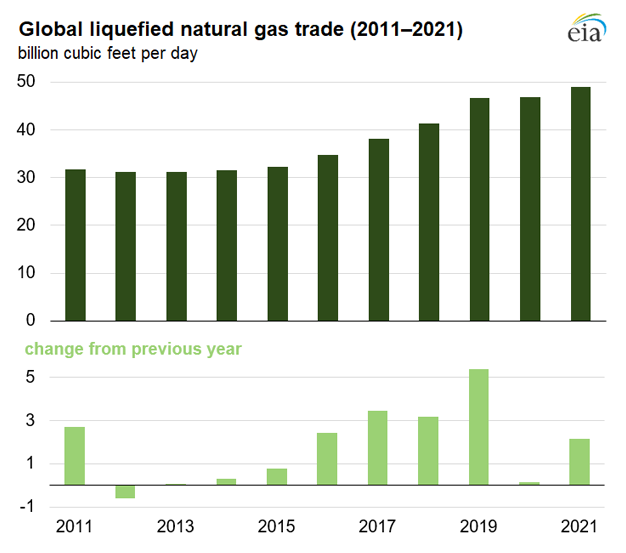 Data source: International Group of Liquefied Natural Gas Importers (GIIGNL), The LNG Industry annual reports (2012–2022)
Data source: International Group of Liquefied Natural Gas Importers (GIIGNL), The LNG Industry annual reports (2012–2022)
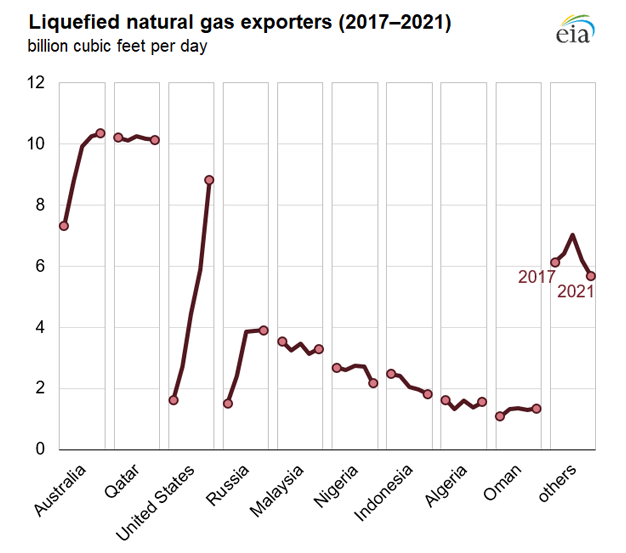 Data source: International Group of Liquefied Natural Gas Importers (GIIGNL), The LNG Industry annual reports (2018–2022)
Data source: International Group of Liquefied Natural Gas Importers (GIIGNL), The LNG Industry annual reports (2018–2022)
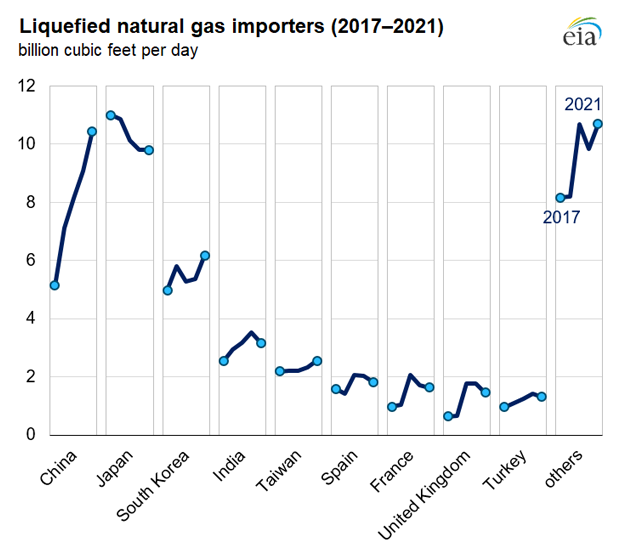 Data source: International Group of Liquefied Natural Gas Importers (GIIGNL), The LNG Industry annual reports (2018–2022)
Data source: International Group of Liquefied Natural Gas Importers (GIIGNL), The LNG Industry annual reports (2018–2022)
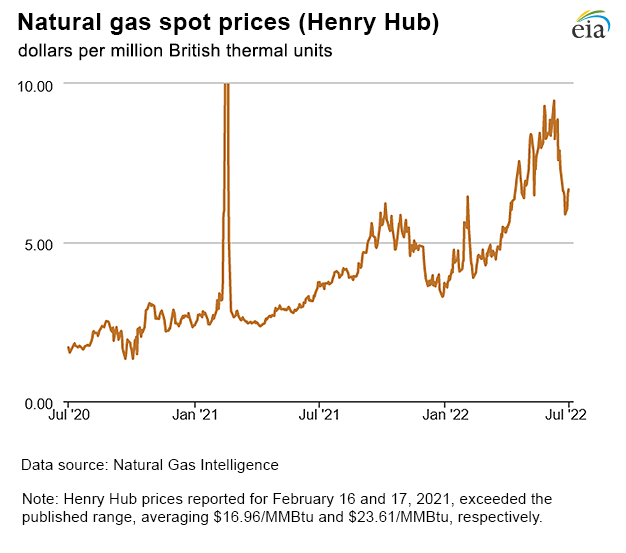
| Spot Prices ($/MMBtu) | Thu, 23-Jun |
Fri, 24-Jun |
Mon, 27-Jun |
Tue, 28-Jun |
Wed, 29-Jun |
|---|---|---|---|---|---|
| Henry Hub | 6.47 | 5.89 | 6.07 | 6.55 | 6.67 |
| New York | 5.63 | 5.78 | 5.61 | 6.07 | 6.51 |
| Chicago | 6.41 | 5.91 | 6.05 | 6.47 | 6.55 |
| Cal. Comp. Avg.* | 7.27 | 6.53 | 7.01 | 7.12 | 7.02 |
| Futures ($/MMBtu) | |||||
| July Contract | 6.239 | 6.22 | 6.501 | 6.551 | Expired |
| August Contract | 6.283 | 6.28 | 6.546 | 6.570 | 6.498 |
| September Contract | 6.280 | 6.26 | 6.540 | 6.557 | 6.493 |
| Data source: Natural Gas Intelligence and CME Group as compiled by Bloomberg, L.P. *Avg. of NGI's reported prices for: Malin, PG&E Citygate, and Southern California Border Avg. |
|||||
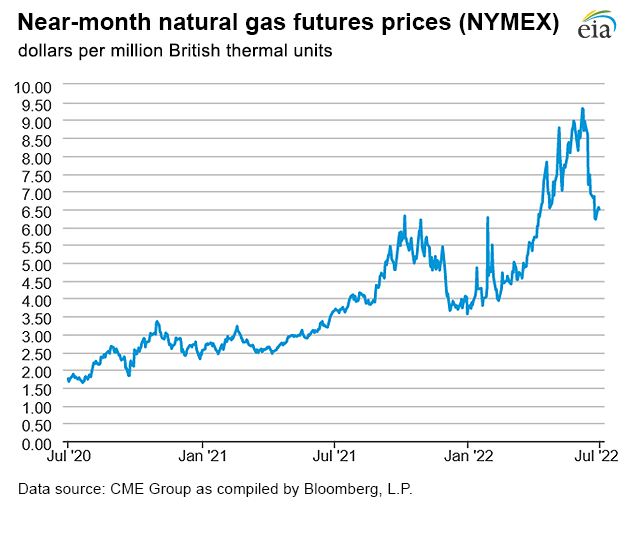
| U.S. natural gas supply - Gas Week: (6/23/22 - 6/29/22) | |||
|---|---|---|---|
Average daily values (billion cubic feet) |
|||
this week |
last week |
last year |
|
| Marketed production | 108.0 |
107.6 |
104.8 |
| Dry production | 95.9 |
95.5 |
92.7 |
| Net Canada imports | 5.6 |
5.6 |
4.4 |
| LNG pipeline deliveries | 0.1 |
0.1 |
0.1 |
| Total supply | 101.6 |
101.2 |
97.1 |
|
Data source: PointLogic | |||
| U.S. natural gas consumption - Gas Week: (6/23/22 - 6/29/22) | |||
|---|---|---|---|
Average daily values (billion cubic feet) |
|||
this week |
last week |
last year |
|
| U.S. consumption | 68.4 |
68.5 |
65.7 |
| Power | 39.1 |
38.6 |
35.5 |
| Industrial | 21.0 |
21.0 |
21.1 |
| Residential/commercial | 8.4 |
8.9 |
9.0 |
| Mexico exports | 5.8 |
5.8 |
6.5 |
| Pipeline fuel use/losses | 6.5 |
6.5 |
6.3 |
| LNG pipeline receipts | 10.5 |
10.7 |
10.9 |
| Total demand | 91.3 |
91.5 |
89.4 |
|
Data source: PointLogic | |||
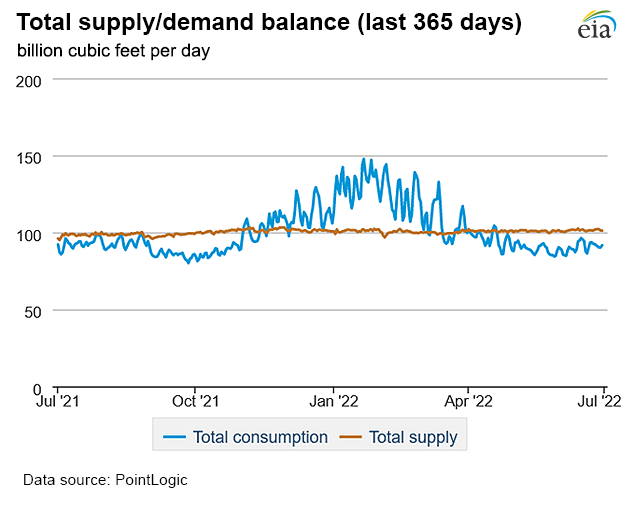
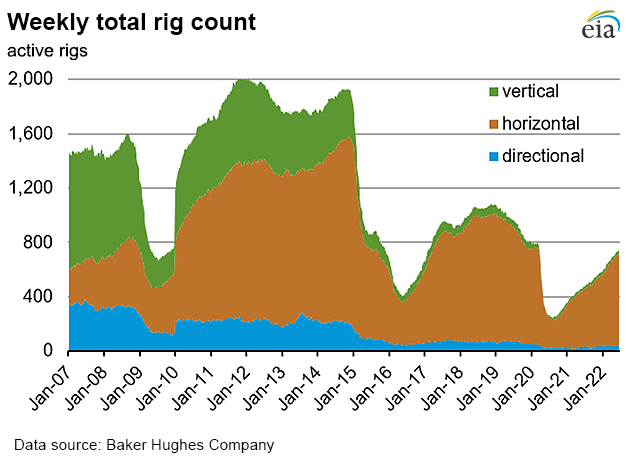
| Rigs | |||
|---|---|---|---|
Tue, June 21, 2022 |
Change from |
||
last week |
last year |
||
| Oil rigs | 594 |
1.7% |
59.7% |
| Natural gas rigs | 157 |
1.9% |
60.2% |
| Note: Excludes any miscellaneous rigs | |||
| Rig numbers by type | |||
|---|---|---|---|
Tue, June 21, 2022 |
Change from |
||
last week |
last year |
||
| Vertical | 27 |
0.0% |
42.1% |
| Horizontal | 685 |
1.6% |
62.7% |
| Directional | 41 |
5.1% |
36.7% |
| Data source: Baker Hughes Company | |||
| Working gas in underground storage | ||||
|---|---|---|---|---|
Stocks billion cubic feet (Bcf) |
||||
| Region | 2022-06-24 |
2022-06-17 |
change |
|
| East | 461 |
430 |
31 |
|
| Midwest | 535 |
506 |
29 |
|
| Mountain | 134 |
128 |
6 |
|
| Pacific | 235 |
231 |
4 |
|
| South Central | 886 |
875 |
11 |
|
| Total | 2,251 |
2,169 |
82 |
|
| Data source: U.S. Energy Information Administration Form EIA-912, Weekly Underground Natural Gas Storage Report | ||||
| Working gas in underground storage | |||||
|---|---|---|---|---|---|
Historical comparisons |
|||||
Year ago (6/24/21) |
5-year average (2017-2021) |
||||
| Region | Stocks (Bcf) |
% change |
Stocks (Bcf) |
% change |
|
| East | 509 |
-9.4 |
526 |
-12.4 |
|
| Midwest | 619 |
-13.6 |
603 |
-11.3 |
|
| Mountain | 172 |
-22.1 |
158 |
-15.2 |
|
| Pacific | 243 |
-3.3 |
266 |
-11.7 |
|
| South Central | 1,003 |
-11.7 |
1,020 |
-13.1 |
|
| Total | 2,547 |
-11.6 |
2,573 |
-12.5 |
|
| Data source: U.S. Energy Information Administration Form EIA-912, Weekly Underground Natural Gas Storage Report | |||||
| Temperature – heating & cooling degree days (week ending Jun 23) | ||||||||
|---|---|---|---|---|---|---|---|---|
HDDs |
CDDs |
|||||||
| Region | Current total |
Deviation from normal |
Deviation from last year |
Current total |
Deviation from normal |
Deviation from last year |
||
| New England | 23 |
14 |
14 |
7 |
-11 |
-25 |
||
| Middle Atlantic | 9 |
4 |
1 |
16 |
-16 |
-17 |
||
| E N Central | 6 |
0 |
-6 |
53 |
15 |
17 |
||
| W N Central | 0 |
-7 |
-8 |
84 |
34 |
23 |
||
| South Atlantic | 1 |
1 |
0 |
82 |
2 |
3 |
||
| E S Central | 0 |
0 |
-1 |
92 |
17 |
22 |
||
| W S Central | 0 |
0 |
0 |
135 |
28 |
23 |
||
| Mountain | 9 |
-8 |
7 |
53 |
-7 |
-39 |
||
| Pacific | 13 |
1 |
12 |
25 |
-1 |
-31 |
||
| United States | 7 |
0 |
1 |
60 |
5 |
-2 |
||
|
Data source: National Oceanic and Atmospheric Administration Note: HDDs=heating degree days; CDDs=cooling degree days | ||||||||
Average temperature (°F)
7-day mean ending Jun 23, 2022
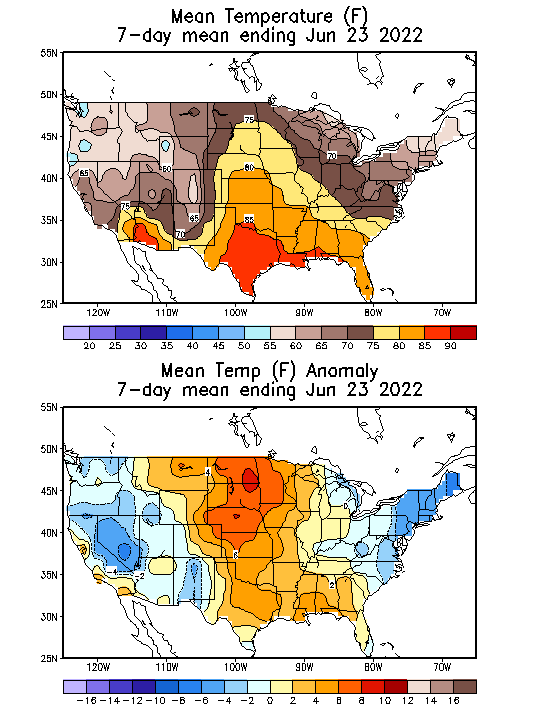
Data source: National Oceanic and Atmospheric Administration
Deviation between average and normal temperature (°F)
7-day mean ending Jun 23, 2022

Data source: National Oceanic and Atmospheric Administration

